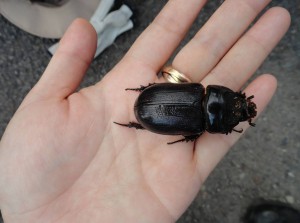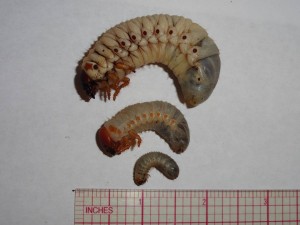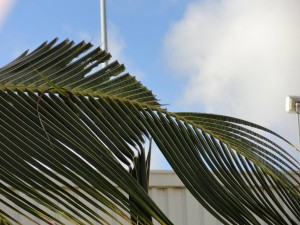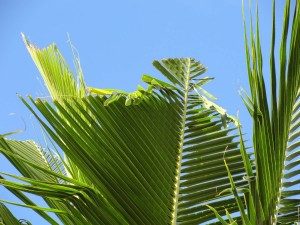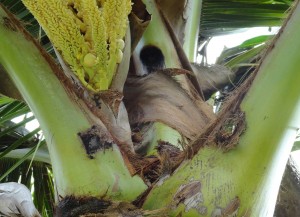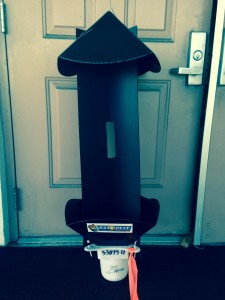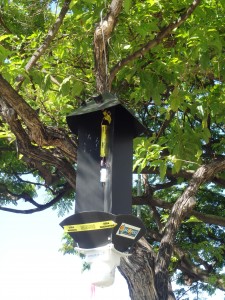Coconut Rhinoceros Beetle Found Near Mililani
Posted on Oct 21, 2014 in MainFourth Buffer Zone Created Around Leilehua Golf Course
NR14-25
Oct. 21, 2014
HONOLULU — Another live adult coconut rhinoceros beetle (CRB) has been found outside of the known infestation area on Oahu. Yesterday afternoon, CRB crews found a live female beetle in a survey trap near Mililani – south of the Leilehua Golf Course. This is several miles north of where CRB have been previously found on Oahu. On Oct. 16, a sole male adult CRB was found in a trap near the Diamond Head Lookout.
Previously, CRB continued to be found within a six-mile zone around Joint Base Pearl Harbor-Hickam (JBPH-H) were the pest was initially found in December 2013. A second two-mile buffer zone was created in the Campbell Industrial Park area after a CRB was found in a survey trap in July 2014 and a third two-mile buffer zone is being established around the Diamond Head Lookout. Now, a fourth buffer zone will be established around the latest detection.
Crews will be deploying traps in higher density in the new buffer zones and conducting additional surveys for breeding sites and damage to coconut trees.
“With these new detections, the CRB team will be reassessing our strategy,” said Scott Enright, chairperson of the Hawaii Board of Agriculture. “We remain confident that CRB can eventually be eradicated and are establishing a 46-member team to work on this mission alone.”
Since CRB was first detected, crews have set about 2,300 panel traps all over Oahu and surveyed more than 95,000 palm trees and 280 mulch sites. About 130 palm trees have been removed and destroyed. About 1,000 adult beetles, 1,100 larvae and 16 pupae have been found on Oahu. The majority of the CRB detections remains within the six-mile buffer zone with JBPH-H as the center.
”We ask that residents on Oahu, especially in the detection areas, keep surveying their palm trees for damage and also remove any mulch piles where larvae may be reproducing,” said Robert Curtiss, HDOA entomologist and CRB incident commander. “Residents may also call the team to find out how to properly destroy mulch piles so they do not serve as a reservoir for the CRB.”
The CRB team may be reached directly at 679-5244 or e-mailed at: [email protected]
CRB is a major pest of palms in India, the Philippines, the Palaus, Fiji, Wallis, Nukunono, American and Western Samoa and Guam. CRB is mainly a pest of coconut and oil palms, but may also attack other palm species. Adult CRB are dark brown in color and very large – measuring 1 ¼ to 2 ½ inches long. CRB larvae are white in color with a brown head. (Photos attached)
The beetles damage palms by boring into the center of the crown where they injure young, growing tissue and feed on the sap. As they bore into the crown, they cut through developing leaves, causing damage to the fronds. V-shaped cuts in the fronds and holes through the midrib are visible as leaves mature and unfold.
CRB is native to the Asian tropics, but was accidentally introduced to western and central Pacific islands.
Natural enemies of CRB include pigs, rats, ants, and some beetles, which may attack CRB eggs, larvae, pupae and adults. In Hawaii, it is suspected that cattle egrets and mongoose may also feed on the beetles. CRB may also be killed by two diseases, a fungus and a virus; however, both are not known to occur in Hawaii.
A multi-agency group has been working under the Incident Command System to manage this eradication program. Agencies currently involved include: Hawaii Department of Agriculture, U.S. Department of Agriculture, U.S. Navy, Dept. of Land and Natural Resources, UH-College of Tropical Agriculture and Human Resources, Oahu Invasive Species Committee and others. Funding has also been received from the U.S. Department of Agriculture and the Hawaii Invasive Species Council.
Suspected CRB should be reported to the state’s toll-free PEST HOTLINE – 643-PEST (7378).For updated information on CRB in Hawaii, go to the HDOA website at: https://hdoa.hawaii.gov/pi/main/crb/
###

